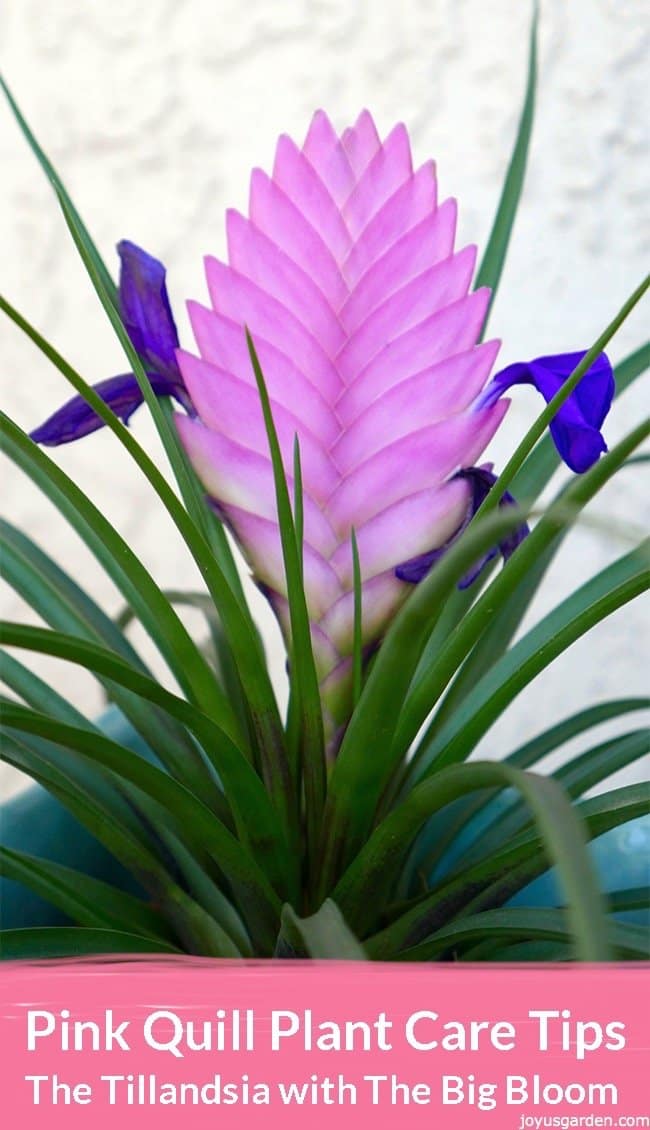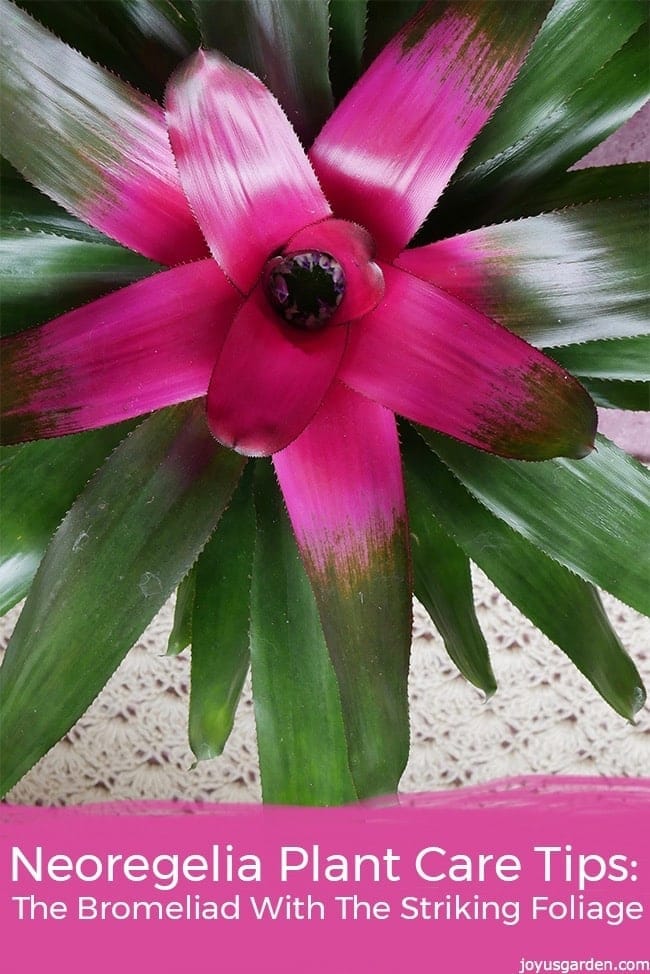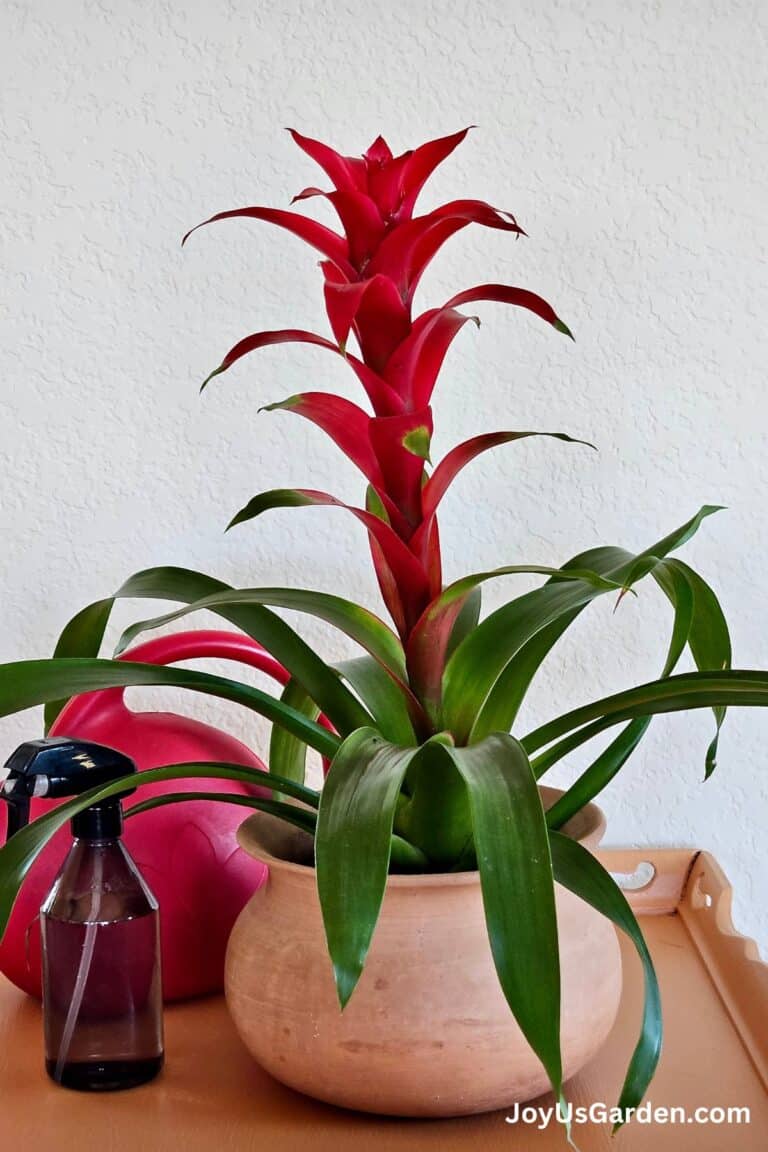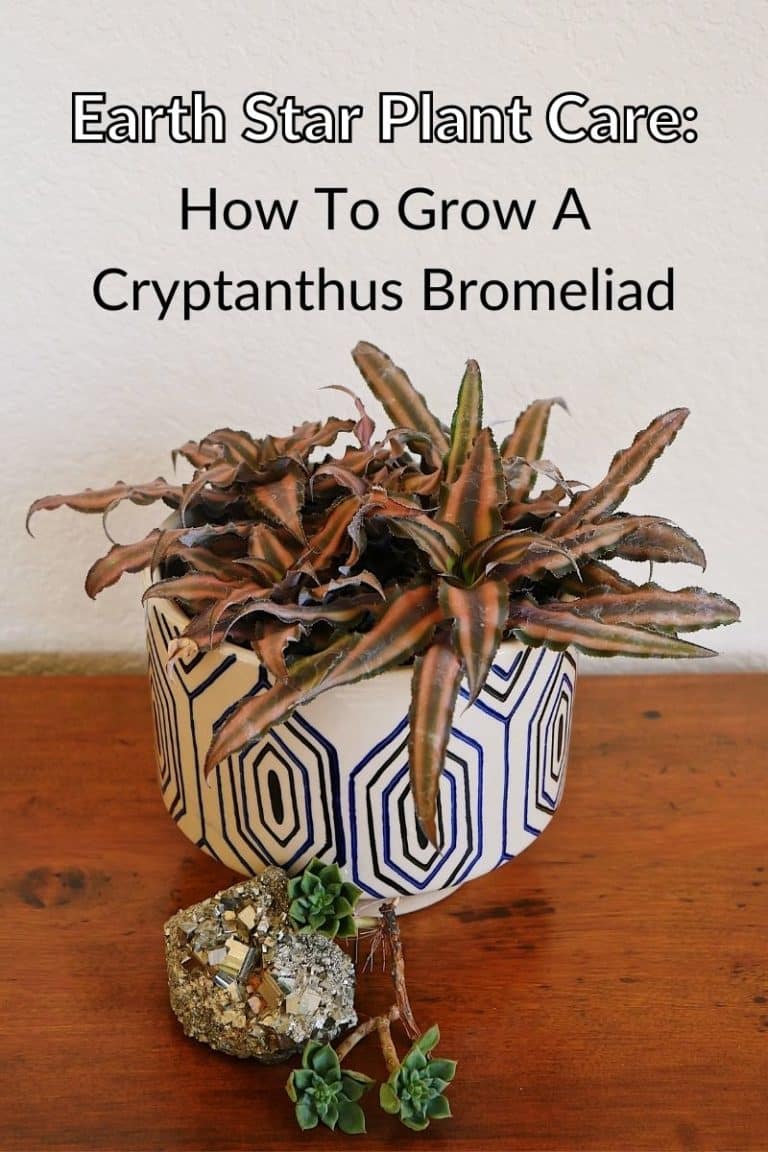Air Plant Care In A Dry Climate
Air plants have been a hot ticket for more than 15 years and are showing no signs of slowing down in popularity. They used to be hard to find but now you can purchase these fascinating beauties from many online sources. I’ve lived in the Sonoran Desert in Tucson, AZ for 3 years and to say the humidity is low, is putting it mildly. Here’s what I’ve learned about air plant care in a dry climate.
I wanted to do this post because most homes and offices have dry air also. Air conditioning, and some types of heating and fireplaces, cause our indoor environments to be less humid.
You’d think that a plant which didn’t grow in soil would be easy to grow. I know some of you struggle with growing air plants in your homes. Many air plants (aka Tillandsias) thrive on humidity and moisture so I hope these points will help you out.
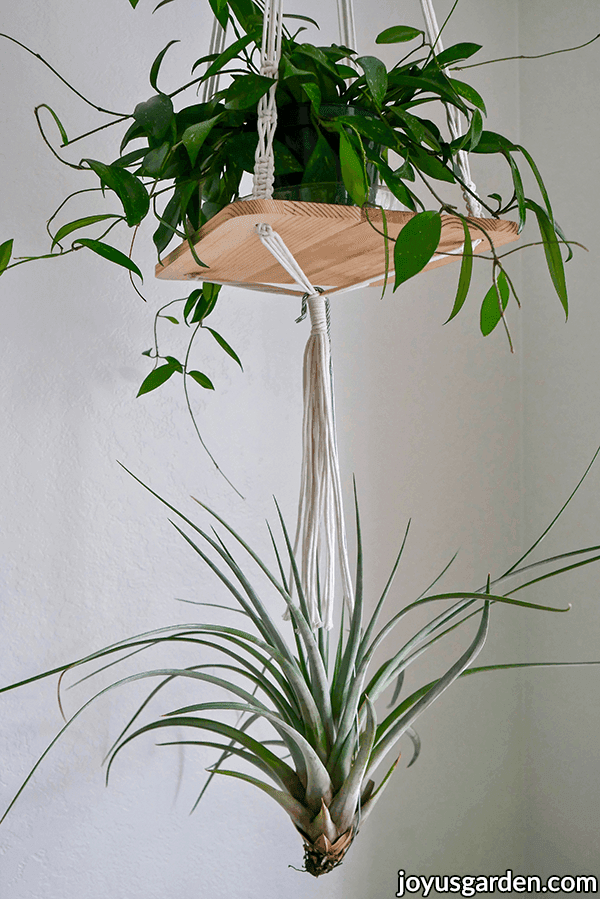
My Tillandsia fasciculata hangs off a Hoya carnosa in the dining room. It enjoys the bright natural light coming in through the windows.
When living in Santa Barbara, I grew a few air plants indoors but mostly outdoors. They loved the fog and thrived in the mild coastal climate. Most pupped (produced babies) and some flowered. Caring for them was easy and not a whole lot of attention or babying was required on my part.
Here in Tucson it’s a different story. I grow all my air plants indoors because the summers are too hot (100F+), sunny and dry and the winter evening temps can dip below 32F. Many aspects of their care is the same as when growing in a more humid climate. The big difference is in the watering – mainly the frequency.
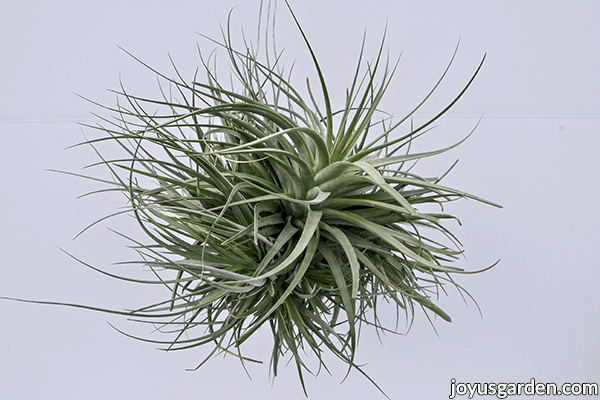
My Tillandsia concolor hangs off another hoya in the kitchen close to sliding glass doors.
Some Of Our General Houseplant Guides For Your Reference:
- Guide To Watering Indoor Plants
- Beginner’s Guide To Repotting Plants
- 3 Ways To Successfully Fertilize Indoor Plants
- How to Clean Houseplants
- Winter Houseplant Care Guide
- Plant Humidity: How I Increase Humidity For Houseplants
- Buying Houseplants: 14 Tips For Indoor Gardening Newbies
- 11 Pet-Friendly Houseplants
Air Plant Care Tips
Air Plant Choice
Some air plants are better adapted to grow in drier climates. Those with fuzzy leaves (technically called trichomes), thicker leaves & silvery leaves are good choices.
Air plants with fine, non-fuzzy are harder to grow in dry air. They’ll need soaking or misting every day or every other day.
Good choices: Tillandsia xerographica, Tillandsia tectorum, Tillandsia gardneri & Tillandsia duratii grow in dry climates. Besides the xerographica, my Tillandsia caput-medusae & Tillandsia xerographica x brachcaulos do the best. Not far behind hardiness wise are my Tillandsia concolor (the large ball) & Tillandsia fasciculata.
Ionanthas are probably the most common air plants & are well worth a try. They are small, tough & cost less than many of the other air plants. I have 2 of them growing in small clumps.
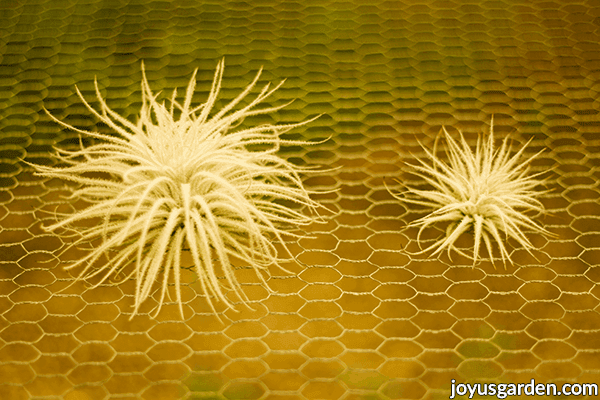
A pair of tectorums. The fuzzy, silvery leaves are what help them grow in drier environments.
Size
Keep in mind smaller air plants need watering more often. I have a few of them & we’ll see how long they thrive. So far so good but I have at least 40 houseplants & an outdoor garden to tend. I definitely won’t be buying any more smaller ones!
Larger air plants & air plants which grow in clumps have proved to be hardier, water wise, for me.
Exposure
Bright natural light is best. Air plants are not low light plants. Just because they don’t grow in soil doesn’t mean they don’t need light.
Conversely, don’t place them in direct, hot sun. If it’s filtered through a curtain, that’s fine.
I keep mine about 3-5′ away from windows & under a skylight.
The darker green types are better suited to handle lower (but not low) light exposures.
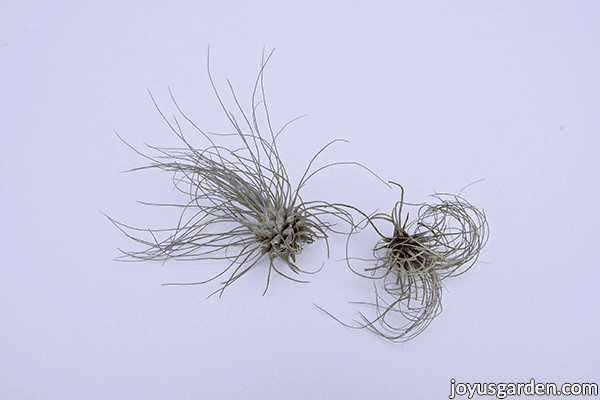
Here are two Tillandsia fuchsii; their fine non-fuzzy leaves mean they need watering much more often in a dry climate. The 1 on the right is almost completely dried up because I don’t water it every day. I bought them only to show to you as an example of what doesn’t do well unless you’re willing to soak or mist them every day.
Location
The key for growing air plants in a dry climate is to keep the moisture level up. All but 1 of my air plants in the kitchen because this is the room where the water runs the most.
A bathroom would be fine (air plants would love the steamy air coming from showers) but just make sure it has good natural light.
Air Circulation
Air plants need it. I open up my windows when possible so the air can move around. Seeing air plants in those mostly closed in glass globes with small openings drives me nuts. I feel it’s fine to give them as gifts this way but don’t leave them in there for the long haul.
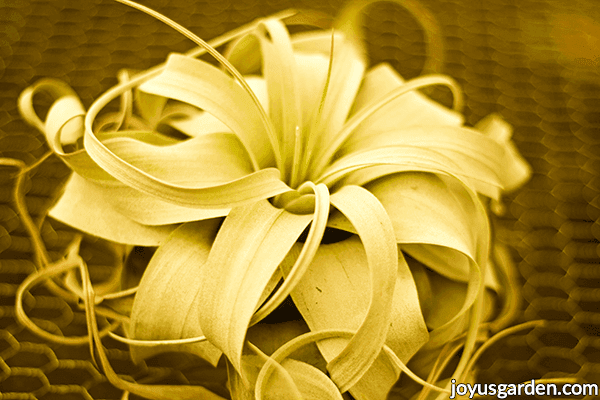
Tillandsia xerographica does well in dry climates. Xero means dry after all!
Watering
This is where the big difference comes in terms of air plant care. You’ll need to soak &/or mist your air plants more often.
It’s good to know that air plants collect water & nutrients through their leaves, not their roots.
I soak my 3 larger air plants in a big, oval tub (which you’ll see in the video) every 5-7 days. My concolor & fasciata get soaked for 4-18 hours whereas I only soak the xerographica for a couple of hours.
I soak my smaller air plants for 1/2 an hour 2 times a week & mist them every other day. It’s a bit of work but I can do it when I’m taking a break from writing blog posts!
I soak them upside down or on their sides so that the leaves can intake the water. The role of the roots/root end is primarily to anchor the air plant to whatever it’s growing on. Regularly soaking the root end for hours can lead to rot.
Be sure to shake them off after soaking because air plants don’t like to have water sitting in their centers, especially in lower light/cooler conditions.
As a side note, here’s how I watered my air plants growing outside in Santa Barbara: I misted them every 2 weeks; less so in the rainy or foggy times. I soaked them every 3-4 weeks in warmer months. Much easier in terms of air plant care!
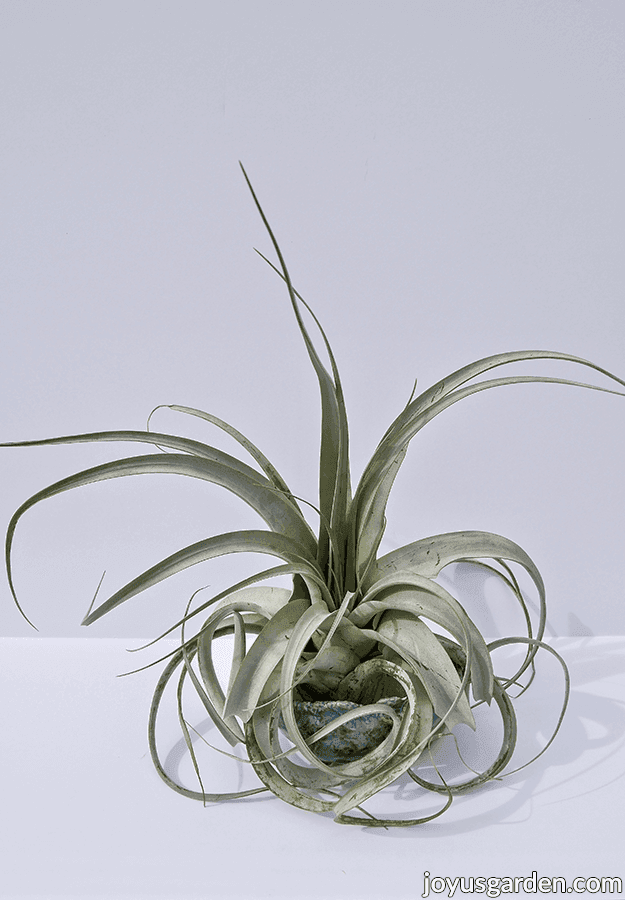
My xerographica. Most of them I’ve seen grow in more of a ball shape like above, but mine has a more open form.
Water Quality
This can be confusing. Some say tap water (without an excess of chlorine) is fine; whereas some swear by bottled spring water or filtered water. I really can’t say because I’ve always used filtered water for my air plants. My home in Santa Barbara had a reverse osmosis system & my kitchen faucet here in Tucson has a filtration system.
Either way, they do need nutrients that come from a water source so I’m not sure about purified water. I do know someone who uses purified water for his air plants but he puts food in the water every time he soaks them.
Of course, rainwater is best. We just had 3 days of rain off & on so I put my air plants outside.
What Does an Air Plant Dislike?
Soil
Air plants are epiphytic in nature which means they grow on other plants. Don’t plant yours in soil. The only Tillandsia (that I know of) which can grow in a mix is the Pink Quill Plant.
To have water on them for too long
Although they do like to be soaked, don’t leave them in too long. Be sure to give them a good shake off after soaking. You don’t want water sitting in the centers. Although they love their waterings, know that they can rot out.
Chlorine & water with a lot of minerals
I touched on this above. Air plants are in the bromeliad family & they don’t like a build-up of salts.
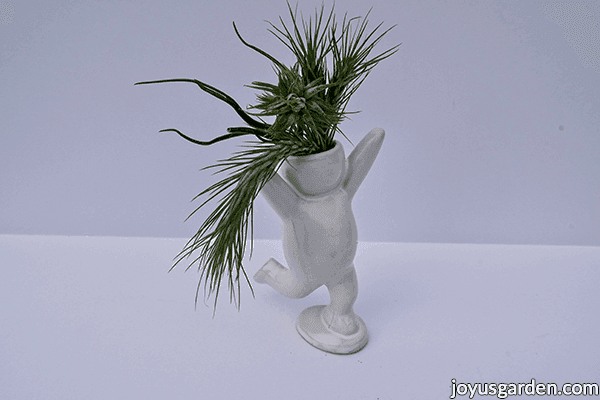
I’m not big on tchotchkes, but couldn’t resist this little air plant holder!
Copper
This is toxic to air plants. Avoid soaking your air plants in a copper bowl or displaying them on or with copper wire.
Low light or direct, hot sun.
They need bright light to grow & direct, hot sun hitting them will cause burn.
To be placed near air conditioning/heating vents.
Also, keep them away from operating fireplaces.
To sit in water too long
Even though they love frequent watering in a dry climate, they don’t like to sit in water or have water collecting on them for too long.
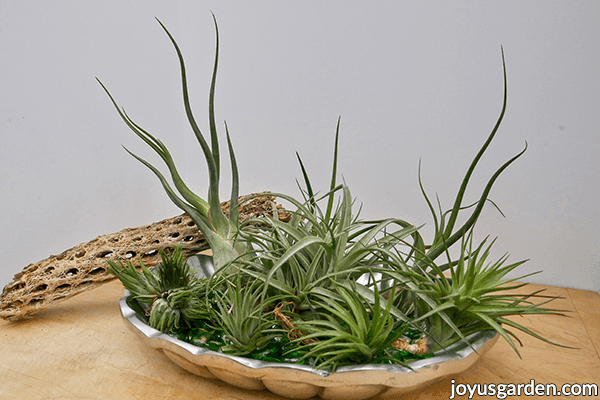
My tray of air plants which sits in the kitchen. I take them out of the tray to soak them. And when I mist them, I do it lightly so water doesn’t build up in the tray.
What Does an Air Plant Like?
- To have dead flowers & leaves taken off – because, it looks better.
- Filtered sunlight – although they don’t like hot sun, filtered is fine.
- To be watered in the daytime – they breathe at night.
- Room temperature water – much better for all houseplants.
- Warm temperatures—although they’ll adapt to a wide range of temps, they’ll do much better in the warmth.
Feeding
I didn’t feed my air plants in Santa Barbara. The majority (all but 3) grew outdoors on my porch & in my garden. Plant matter blowing around & falling on them from above fed them which is how they get their nutrients in nature.
Now that I grow air plants indoors, I plan on soaking them in Eleanor’s VF-11 once a month in spring, summer & early fall. I’ll let you know how it goes. My friends at Eco Gro love this non-burning plant food for nourishing air plants. It not only feeds plants through the roots but can also be used as a foliar feed (what air plants need). When I’m done soaking the air plants, I use the water for my houseplants.
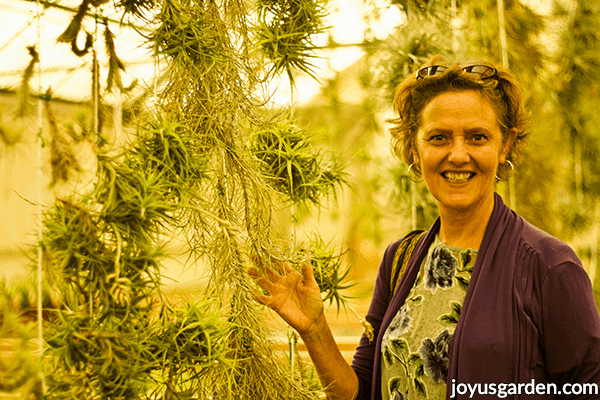
Smiling & happy in a tillandsia grower’s greenhouses.
The Roots
This has nothing to do with air plant care but it’s something you may be curious about. Oftentimes air plants come with roots hanging off the base. As I said, the way that air plants absorb moisture is through their leaves. The roots are just a means for them to anchor onto other plants.
Feel free to cut the roots off. They’re usually all dried up by the time they reach you & won’t come back to life. I think they look better trimmed off and are easier to display without dry roots hanging out. Just make sure you don’t cut the roots too close to the base of the air plant. You’ll see me illustrate this in the video.
Conclusion
Air plant care requires a bit more time in a dry climate (or your dry home) but I feel it’s well worth it. Some air plants are better adapted to handle drier environments making those better choices. You’ll need to soak and/or mist your air plants more often. And, be sure to place them in bright, natural light to have them do their best. Fascinating beauties indeed!
Happy gardening,


